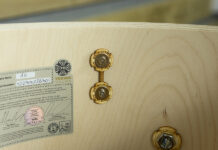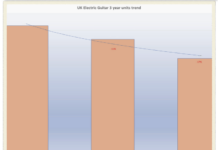
Stealing Guitar Solo Ideas from Miles Davis
Miles Davis’ 1959 album Kind of Blue and his song “So What” often represent a gateway into jazz for many musicians with rock, pop or blues backgrounds.
But while some of us are drawn to the opening chords of “So What” and learn them on the guitar where they fit nicely on the fretboard, we might stop there rather than dig into making single-note shapes out of these same chords.
In today’s lesson, you’ll learn how to take the classic “So What” chord shapes and turn them into single-note soloing ideas in your improvised lines and phrases, bringing a bit of Davis and Bill Evans onto the fretboard at the same time.
The “So What” Chords
As a review, here are the opening chords played by pianist Evans on the classic recording of “So What.” The chords are built by stacking 4th intervals until you hit the top two strings, where there is a 3rd between those last two notes.
Also, there are two different chords going on here under the written Dm7—an Em7 and Dm7 shape that, when combined, outline the intervals written in the last two bars of the example.
Before going on to the next part of this lesson, one thing to take away from the “So What” chords is that when you see Dm7 on a lead sheet, you can move between Dm7 and Em7 in your comping ideas in order to play on the given chord, as well as add color by outlining the R-9-11-5-13 when playing the Em7 chord.
After you’ve reviewed (or learned, if they are new) these shapes in your practicing, it’s time to move on and take the first step into breaking these ideas up and making single-note melodies out of the “So What” chords.
Breaking Up “So What” Chords
While playing these full chord shapes will get the “So What” chords under your fingers, they can be a bit bulky and hard to move around the fretboard, especially at quicker tempos. So the first thing we’ll do is break up these larger chords into smaller shapes that you can then use in your comping ideas and to create single-line melody lines in your jazz guitar solos. Here’s how those shapes would look for both the Em7 and Dm7 “So What” chords, where both have been broken up into three-note groups to make them easier to move around and build single-lines out of.

Now that we’ve broken up the “So What” chords into three smaller shapes for both the Dm7 and Em7 shapes, you can arpeggiate these forms in order to create single-line versions of these chords. You can see an example of this in the following example, where I’ve picked each three-note from the lowest to highest notes in order to create single-line versions of each shape.
Try working these in all 12 keys around the neck to get them under your fingers and into your ears on the fretboard. From a picking perspective, you can use economy picking such as down-down-up for each shape, sweep picking such as down-down-down, or hybrid picking where you would use your pick and fingers to pick each shape.
To keep things simple on the page, I’ve written ascending versions of each shape only, but you can also play down each shape as you work up and down the fretboard using these three-note shapes to break up the “So What” chords on the neck. Once you’ve got these shapes in Dm7 under your fingers, try putting on a Dm7 backing track and soloing over that chord using these shapes as the basis for your lines. From there, you can take these ideas to other keys and tunes when applying them to a soloing situation.

After you have worked these shapes all ascending in the woodshed, move on to the next section of this lesson where you’ll be learning how to add a few variations to these three-note shapes in your practicing.
“So What” Chord Variations
Once you have worked on breaking up the “So What” chords into single-line shapes on the fretboard, you can work these shapes with a few common variations in your practice routine. Here are a few of the variations that I like to use, but feel free to come up with your own after you’ve worked on these in 12 keys in the woodshed. The first variation focuses on playing each three-note shape descending from the highest to lowest note, then moving to the next shape on that chord until you’ve reached the top note. In the second variation, you play the first three-note shape ascending and then the second shape descending until you’ve reached the top of the chord you’re on.
For simplicity, I’ve written these variations out over the Dm7 chord shape we learned earlier, but you can also practice these variations over the Em7 shape as well when moving forward with these ideas in the practice room. You can also put on a Dm7 vamp, or other chord progression, and practice soloing over those harmonies using one or both of these variations to create your improvised lines and phrases when taking these variations to a musical situation.

Now that we’ve looked at a few variations when breaking the “So What” chords into single lines, let’s move on to a sample lick and see how this idea can be applied to a ii V I chord progression.
“So What” Chords Lick
To help get you started with these ideas in a soloing context, here is a sample lick that you can check out and work in the given key of C major, and then in all 12 keys as your work it around the fretboard. As well you can practice applying this lick to tunes you are working on, and when it’s comfortable, begin altering the lick by changing the rhythms, adding in notes, taking notes away, playing bits of the lick, and so forth as you personalize this phrase in your playing.
I’ve used the “So What” chords in the first measure, and then finished the idea with some bebop techniques from there. When you’ve got this lick worked out with the above variations, then try writing out a few of your own as sometimes composition can be a great way to work on improvisation in the practice room.

Do you have any questions on this lesson? Share your thoughts in the COMMENTS section below.
Matt Warnock is the owner of mattwarnockguitar.com, a free website that provides hundreds of lessons and resources designed to help guitarists of all experience levels meet their practice and performance goals. Matt lives in the UK, where he is a lecturer in Popular Music Performance at the University of Chester and an examiner for the London College of Music (Registry of Guitar Tutors).
Source: www.guitarworld.com













